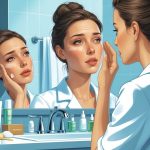Foundation Shade Swaps Makeup Artists Secretly Rely on for Natural Results
Blend Like a Pro: Bronzer and Finishing Techniques
Nobody tells you how much you can mess up if you pick the wrong foundation shade. One bad blend, and it’s patch city. I’ve learned (the hard way) that finishing steps matter more than the foundation itself. Half my life is spent fixing weird bronzer mistakes.
Balancing Color With Bronzer
Three tubes of “universal” bronzer later, I finally get it: undertone is everything. Bronzer isn’t about faking a tan, it’s about fixing the flatness bad foundation leaves. Best tip I got (shoutout to a L’Oréal Paris lead): pick a bronzer just a shade or two deeper than your base, but match your undertone, or you’ll look wild. “Add slow, blend fast, check in daylight—bathroom mirrors lie,” she said. She’s not wrong.
Big fluffy brush? Tempting, but nope. You have to be precise—forehead, cheekbones, jaw, maybe that “3” shape everyone talks about, but blend it way out. If it looks like cocoa powder, wipe it off and start again.
Creating a Seamless Transition Between Shades
If your foundation doesn’t match your jaw or hairline, whatever—bronzer and blending exist for a reason. I’ve had artists attack my face with sponges or duo-fiber brushes, which can go streaky unless you buff like a maniac.
Mess up the blend and you look like Saturn. Sudden color jumps ruin even the fanciest formulas. What I do: after bronzer, I run a damp sponge over my edges. That’s what erases the lines—setting powder alone won’t save you.
Always check in daylight. Tilt your head. If you can’t see where one shade ends and another begins, you’re probably safe for photos. Run a finger over the gradient—if it’s smooth, you’re good.
Preventing and Fixing Common Foundation Shade Mistakes
Foundation is chaos. You leave the house looking fine, then by 2pm you’re orange, patchy, or just… weird. Adjusting is more than a wish and a sponge. Sometimes you just have to panic and hope for the best.
Oxidization: What It Is and How to Avoid It
Artists talk about oxidation like it’s a natural disaster, and yeah, it kind of is. “Color-true” claims? Sure, but humidity, skin oils, and certain SPF ingredients (octinoxate, looking at you) still mess with your shade by mid-afternoon. Supposedly brands test for this, but I don’t trust those store testers—fluorescent lights are liars.
Dr. Shereene Idriss says oily skin or too much iron oxide in the formula is the culprit. She likes oil-control primers with niacinamide (try Paula’s Choice Shine Stopper). Helps, but honestly, it’s mostly about skin prep. Setting powder helps a little. Setting sprays that “lock shade”? Mostly marketing. I just blot and hope for the best.
Correcting an Incorrect Shade
Stuck with the wrong shade? Been there. Sometimes you just have to live with it because, I mean, who has time to start over? Here’s what I do, and I totally stole this from a backstage artist: grab whatever moisturizer is closest (CeraVe, Embryolisse, whatever’s not expired), mix a dab into your foundation, and smear it on. It won’t magically fix everything, but at least your skin looks more like, well, your actual skin. Still looks weird? Bronzer and contour become your best friends—just slap them on the spots that need help and skip the “bronze everywhere” move unless you want to look like a sci-fi extra.
You could buy those shade adjuster things (NYX, LA Girl, they’re fine), but honestly, I’ve watched someone just use a lighter concealer right in the middle of the face to fake a gradient. Looks way more “intentional” than you’d think. Oh, and if your foundation is too yellow? I’ve mixed in a bit of cream blush—sounds wrong, somehow works. Powder blush just sits there and mocks you. Nobody ever admits it, but testing makeup in actual daylight (like, half your face in the window) is the only thing that actually works. Forget apps and “analysis.” Just go outside and look at your own face.
Personalized Recommendations and Technology in Foundation Matching
Weird shade lines haunt me. Every time I think I’ve cracked it, I end up in a store with a stripe down my jaw, looking ridiculous. I keep hoping some genius will invent a foolproof fix, because honestly, wasting money on the wrong NARS shade is a special kind of pain. Digital matching tools are everywhere now. I’m not saying I trust them, but they’re fun to mess with if you’re bored or just hate returning stuff.
Leveraging Online Tools and In-Store Services
Regret from online shade picks? Yeah, my camera roll is a graveyard. AI shade matchers—tried one from Match My Makeup last week—are scarily fast and kind of accurate, but let’s be real, I still don’t trust them after last summer’s foundation meltdown at a beach wedding. Their algorithm claims it matches undertones and finish, and they throw around numbers like “87% customer match rate.” Sure. Virtual try-ons, like Sofiqe, sometimes work even under those weird bathroom lights, which is suspicious because nothing matches my actual bathroom mirror.
Every makeup artist I trust says, “Just swatch in daylight.” The best stores (Sephora, Nordstrom, whatever) have digital scanners and printouts, but if there’s not a real human double-checking, I’m out. I once saw an artist mix Fenty with a single drop of MAC adjuster and it was perfect. No app can do that. It’s like, you can swipe on Tinder all you want, but the real thing is never what the algorithm says.



